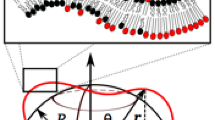Abstract
Common models for two-phase lipid bilayer membranes are based on an energy that consists of an elastic term for each lipid phase and a line energy at interfaces. Although such an energy controls only the length of interfaces, the membrane surface is usually assumed to be at least C 1 across phase boundaries. We consider the spontaneous curvature model for closed rotationally symmetric two-phase membranes without excluding tangent discontinuities at interfaces a priorily. We introduce a family of energies for smooth surfaces and phase fields for the lipid phases and derive a sharp interface limit that coincides with the Γ-limit on all reasonable membranes and extends the classical model by assigning a bending energy also to tangent discontinuities. The theoretical result is illustrated by numerical examples.
Similar content being viewed by others
References
Alberti, G.: Variational models for phase transitions, an approach via Γ-convergence. In: Calculus of variations and Partial Differential Equations (Pisa, 1996), pp. 95–114. Springer, Berlin (2000)
Ambrosio L., Tortorelli V.M.: Approximation of functionals depending on jumps by elliptic functionals via Γ-convergence. Commun. Pure Appl. Math. 43(8), 999–1036 (1990)
Baumgart T., Hess S.T., Webb W.W.: Imaging coexisting fluid domains in biomembrane models coupling curvature and line tension. Nature 425, 821–824 (2003)
Bellettini G., Mugnai L.: Approximation of Helfrich’s functional via diffuse interfaces. SIAM J. Math. Anal. 42(6), 2402–2433 (2010)
Braides, A.: Γ-convergence for beginners, Oxford Lecture Series in Mathematics and its Applications, vol. 22. Oxford University Press, Oxford (2002)
Buttazzo G., Giaquinta M., Hildebrandt S.: One-dimensional variational problems. Oxford Lecture Series in Mathematics and its Applications, vol. 15. Oxford University Press, Oxford (1998)
Canham P.B.: The minimum energy of bending as a possible explanation of the biconcave shape of the human red blood cell. J. Theor. Biol. 26(1), 61–81 (1970)
do Carmo, M.P.: Differential geometry of curves and surfaces. Prentice-Hall Inc., Englewood Cliffs, NJ (1976)
Döbereiner H.G., Käs J., Noppl D., Sprenger I., Sackmann E.: Budding and fission of vesicles. Biophys. J. 65(4), 1396–1403 (1993)
Elliott C.M., Stinner B.: Modeling and computation of two phase geometric biomembranes using surface finite elements. J. Comput. Phys. 229(18), 6585–6612 (2010)
Elliott C.M., Stinner B.: A surface phase field model for two-phase biological membranes. SIAM J. Appl. Math. 70(8), 2904–2928 (2010)
Evans E.A.: Bending resistance and chemically induced moments in membrane bilayers. Biophys. J. 14(12), 923–931 (1974)
Helfrich W.: Elastic properties of lipid bilayers: theory and possible experiments. Z. Naturforsch. (C) 28(11-1), 693–703 (1973)
Helmers M. Convergence of an approximation for rotationallysymmetric two-phase lipid bilayer membranes. Preprint (submitted). http://www.iam.uni-bonn.de/users/helmers (2011)
Helmers M.: Snapping elastic curves as a one-dimensional analogue of two-component lipid bilayers. Math. Models Methods Appl. Sci. 21(5), 1027–1042 (2011)
Jülicher F., Lipowsky R.: Shape transformations of vesicles with intramembrane domains. Phys. Rev. E 53(3), 2670–2683 (1996)
Lowengrub J., Rätz A., Voigt A.: Phase-field modeling of the dynamics of multicomponent vesicles: spinodal decomposition, coarsening, budding, and fission. Phys. Rev. E 79(3), 0311–926 (2009)
Mayer U.F., Simonett G.: A numerical scheme for axisymmetric solutions of curvature-driven free boundary problems, with applications to the Willmore flow. Interface. Free Bound 4(1), 89–109 (2002)
Modica L.: The gradient theory of phase transitions and the minimal interface criterion. Arch. Ration. Mech. Anal. 98(2), 123–142 (1987)
Modica, L., Mortola, S. Un esempio di Γ-convergenza. Boll. Un. Mat. Ital. B (5) 14(1), 285–299 (1977)
Seifert, U., Lipowsky, R.: Morphology of vesicles. In: Structure and Dynamics of Membranes, Handbook of Biological Physics, vol. 1, pp. 403–463. North-Holland (1995)
Seifert U., Berndl K., Lipowsky R.: Shape transformations of vesicles Phase diagram for spontaneous-curvature and bilayer-coupling models. Phys. Rev. A 44(2), 1182–1202 (1991)
Siegel D.P., Kozlov M.M.: The Gaussian curvature elastic modulus of N-Monomethylated dioleoylphosphatidylethanolamine: relevance to membrane fusion and lipid phase behavior. Biophys. J 87(1), 366–374 (2004)
Simon, L.: Lectures on geometric measure theory. Proceedings of the Centre for Mathematical Analysis, Australian National University, vol. 3. Australian National University Centre for Mathematical Analysis, Canberra (1983)
Templer R.H., Khoo B.J., Seddon J.M.: Gaussian curvature modulus of an amphiphilic monolayer. Langmuir 14(26), 7427–7434 (1998)
Topping P.: Relating diameter and mean curvature for submanifolds of Euclidean space. Comment. Math. Helv. 83(3), 539–546 (2008)
Tu, Z.C., Ou-Yang, Z.C.: Lipid membranes with free edges. Phys. Rev. E 68(6), 061915 (2003)
Wang X., Du Q.: Modelling and simulations of multi-component lipid membranes and open membranes via diffuse interface approaches. J. Math. Biol. 56(3), 347–371 (2008)
Author information
Authors and Affiliations
Corresponding author
Additional information
Communicated by J. Jost.
Rights and permissions
About this article
Cite this article
Helmers, M. Kinks in two-phase lipid bilayer membranes. Calc. Var. 48, 211–242 (2013). https://doi.org/10.1007/s00526-012-0550-z
Received:
Accepted:
Published:
Issue Date:
DOI: https://doi.org/10.1007/s00526-012-0550-z




